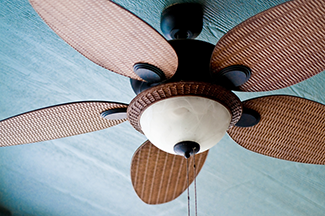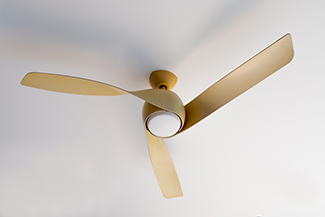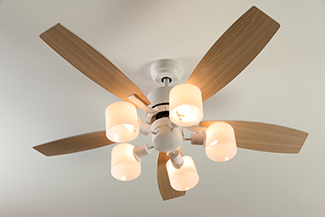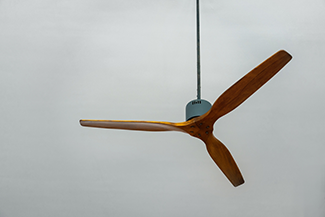Tips For Buying A Ceiling Fan
Tips For Buying A Ceiling Fan
Ceiling fans are a must-have in Arizona. We use them year-round and rely on them for our comfort before having to turn on the air conditioning (and sometimes with it). They can be key in eliminating hot and cold spots in a room and equalizing temperatures throughout the house. Because we use fans so much, they wear out and need to be replaced. When that time comes, take these things into consideration as you shop for a new one.
Budget
 You can find a ceiling fan to fit any budget. The more bells and whistles (brand, lighting, control, finishes, etc.) the more you will pay.
You can find a ceiling fan to fit any budget. The more bells and whistles (brand, lighting, control, finishes, etc.) the more you will pay.
Location
Where will the fan be placed – indoors or outdoors? If it’s going outdoors, it will need to be UL wet-rated. Actually, regardless of where it will be placed, it should be UL rated. If it’s going in a children’s bedroom, make sure the blades can’t be reached when they jump up and down on the beds. If it’s going in a home gym, make sure it is away from swinging arms and barbells.
Style & Finish
There are countless fan styles available – traditional, contemporary, elegant, old-timey, and farmhouse-inspired, just to name a few, and with or without lighting.
The more ornate the finish or the blades, the more difficult the fan will be to keep clean. The woven material on the fan pictured here, would be a nightmare to keep clean in our dusty climate.
Airflow
Today fans are rated by airflow and airflow efficiency. The higher the airflow (cubic feet per minute), the more air the fan moves, the better the airflow efficiency. Motor size, blade pitch, and blade materials contribute to the amount of air a ceiling fan moves.
Be sure to buy an Energy Star fan to maximize your energy savings.
Motor, Energy Efficiency & Number of Fan Blades
 AC motor fans are the most common. However, don’t rule out the DC motor. DC motors use up to 70 percent less electricity than AC versions and are whisper-quiet. They may also help minimize electrical use.
AC motor fans are the most common. However, don’t rule out the DC motor. DC motors use up to 70 percent less electricity than AC versions and are whisper-quiet. They may also help minimize electrical use.
A small, inexpensive motor does not create as much air movement as a larger motor. Before making a purchase, listen to the fan so you can hear if the motor makes too much noise for your liking. A good-quality fan should be fairly quiet.
“The best way to compare ceiling fans from one model to the next would be by comparing the CFMs of each fan. This stands for Cubic Feet per Minute. The higher the CFM rating, the better or more air movement you are going to get. The manufacturers take into account motor size, blade pitch, blade size and motor RPM to determine their CFM rating. You can find a three-blade fan that has a higher CFM rating than a five-blade fan simply because of a better motor or better blade pitch. Also, vice versa, you can find a five- or six blade fan that pushes more air than a three-blade fan as well. By comparing CFM’s, you are getting a good idea of the effectiveness of the air movement you are going to receive because it weighs all the factors when combined in one unit,” says Ashley Childers, Statewide Lighting, a Rosie-Certified Partner.
Lighting
 Most fans come with a light kit or one that can be added. A light kit offers more functionality in a space. Lighting can also add heat to the area directly underneath the fan, so look for light kits that use cooler LED lights.
Most fans come with a light kit or one that can be added. A light kit offers more functionality in a space. Lighting can also add heat to the area directly underneath the fan, so look for light kits that use cooler LED lights.
Size & Mounting
Fan size is based on the square footage of the room. For example:
- 90–100 square feet = 44”- 48” blades sweep
- 90 square feet or less = blade sweep of 15” - 42”
- 100-150 square feet blade sweep of 50”- 54”
Consider using multiple smaller fans if the space is larger than 150 square feet.
The term “blade sweep” refers to the distance around the circle the blades create as they turn.
A flush-mount installation is best for rooms where the ceiling height is less than eight feet. These low-profile ceiling fans install flush against the ceiling, allowing the blades to hang seven feet above the floor. However, flush mounts don’t have the volume of air space above the blades to move as much air.

If the ceiling is higher than eight or nine feet high, buy an extension “down-rod” to lower the fan to the ideal location.
Spin Direction
Make sure the fan has two directions. It used to be that every manufacturer would advise homeowners to set their fan blades to spin counter-clockwise in the summer and clockwise in the winter. That’s often still true, but not for all brands.
Controls
Gone are the days of having to get up to control the speed of the blades or the brightness of the lights. Remotes and wall controls allow you to adjust to your comfort level from your recliner or bed.
Wired or Plugged In
If you plan to stay in the house for a long time, have the fan wired by a professional, licensed electrician. If you don’t plan to stay a long time, buy a fan that can be plugged into the wall. Swag kits allow you to power the ceiling fan from a nearby wall outlet. The swag is a long extension cord that flows from the ceiling fan to the outlet, where it gets plugged in. The electrical cord is threaded through a linked chain, which is hung on ceiling hooks to keep it out of the path of the fan's spinning blades.
In general, fans being used to cool you should only be run when you are in the room. A fan spinning in an empty room doesn’t cool anything and is a waste of energy.
Home Maintenance To-Do: #CeilingFanReplacement
###
Podcast
Tim Hattrick from KNIX's Tim, Ben And Brook In The Morning along with Brady Bogan from KUPD's Morning Mess join in with lots of stories including home improvement talk, scorpion control, Garth Brooks, favorite music growing up and more! LIVE from Sanderson Ford.
Photo Credit
- Shutterstock
Related Content
